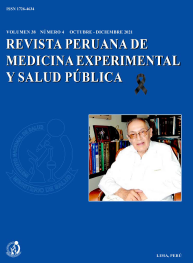Revista de revistas
![]()
PUBLICACIONES DE INVESTIGADORES DEL INS EN REVISTAS INDIZADAS
Mayo
REVISTAS INTERNACIONALES
1. Bailon Calderon H1, Yaniro Coronel VO1, Cáceres Rey OA1, Colque Alave EG1, Leiva Duran WJ1, Padilla Rojas C1,
Montejo Arevalo H1, García Neyra D1, Galarza Pérez M1, Bonilla C2, Tintaya B2, Ricciardi G, Smiejkowska N, Romão E, Vincke C, Lévano J1, Celys M, Lomonte B, Muyldermans S. Development of Nanobodies Against Hemorrhagic and Myotoxic Components of Bothrops atrox Snake Venom. Frontiers in immunology, 11, 655. https://doi.org/10.3389/fimmu.2020.00655 Available from: https://www.ncbi.nlm.nih.gov/pmc/articles/PMC7224310/
ABSTRACT
/a08v26n5_6_img1.png)
Snake envenoming is a globally neglected public health problem. Antivenoms produced using animal hyperimmune plasma remain the standard therapy for snakebites. Although effective against systemic effects, conventional antivenoms have limited efficacy against local tissue damage. In addition, potential hypersensitivity reactions, high costs for animal maintenance, and difficulties in obtaining batch-to-batch homogeneity are some of the factors that have motivated the search for innovative and improved therapeutic products against such envenoming. In this study, we have developed a set of nanobodies (recombinant single-domain antigen-binding fragments from camelid heavy
chain-only antibodies) against Bothrops atrox snake venom hemorrhagic and myotoxic components. An immune library was constructed after immunizing a Lama glama with whole venom of B. atrox, from which nanobodies were selected by phage display using partially purified hemorrhagic and myotoxic proteins. Biopanning selections retrieved 18 and eight different nanobodies against the hemorrhagic and the myotoxic proteins, respectively. In vivo assays in mice showed that five nanobodies inhibited the hemorrhagic activity of the proteins; three neutralized the hemorrhagic activity of whole B. atrox venom, while four nanobodies inhibited the myotoxic protein. A mixture of the anti-hemorrhagic and anti-myotoxic nanobodies neutralized the local tissue hemorrhage and myonecrosis induced by the whole venom, although the nanobody mixture failed to prevent the venom lethality. Nevertheless, our results demonstrate the efficacy and usefulness of these nanobodies to neutralize important pathologies of the venom, highlighting their potential as innovative therapeutic agents against envenoming by B. atrox, a viperid species causing many casualties in South America.
Keywords: nanobodies, snake, venom, myotoxic, hemorrhagic, neutralization, Bothrops atrox, Viperidae
2. Freire J3, Simões S, Sanches F. Clinical and biological characteristics of Enteroviral Meningitis. BOLETÍN DE MALARIOLOGÍA Y SALUD AMBIENTAL; 60 (2): 132-137. Available from: http://www.boletinmsa.com/index.php/path/article/view/565/571
ABSTRACT
/a08v26n5_6_img3.png)
Enteroviruses are known worldwide as a common cause of aseptic meningitis, with both epidemic and endemic patterns, in patients of all ages. Although enteroviral meningitis is usually benign, the clinical features and CSF findings associated with the disease canoverlap thoseof bacterial or herpetic infections, resulting in prolonged hospital stays and initiation of presumptive treatment until the diagnosis is made.
Keywords: Enteroviral Meningitis, Diagnosis, Polymerase Chain Reaction, Serum Specimens
3. Munayco C, Tariq A, Rothenberg R, Soto-Cabezas G, Reyes M, Valle A, Rojas-Mezarina L3, Cabezas C3, Loayza M, Chowell G, & Peru COVID-19 working group. Early transmission dynamics of COVID-19 in a southern hemisphere setting: Lima-Peru: February 29th-March 30th, 2020. Infectious Disease Modelling, 5, 338–345. Available from: https://doi.org/10.1016/j.idm.2020.05.001
ABSTRACT
/a08v26n5_6_img4.png)
The COVID-19 pandemic that emerged in Wuhan China has generated substantial morbidity and mortality impact around the world during the last four months. The daily trend in reported cases has been rapidly rising in Latin America since March 2020 with the great majority of the cases reported in Brazil followed by Peru as of April 15th, 2020. Although Peru implemented a range of social distancing measures soon after the confirmation of its first case on March 6th, 2020, the daily number of new COVID-19 cases continues to accumulate in this country. We assessed the early COVID-19 transmission dynamics and the effect of social distancing interventions in Lima, Peru.
We estimated the reproduction number, R, during the early transmission phase in Lima from the daily series of imported and autochthonous cases by the date of symptoms onset as of March 30th, 2020. We also assessed the effect of social distancing interventions in Lima by generating short-term forecasts grounded on the early transmission dynamics before interventions were put in place.
Prior to the implementation of the social distancing measures in Lima, the local incidence curve by the date of symptoms onset displays near exponential growth dynamics with the mean scaling of growth parameter, p, estimated at 0.96 (95% CI: 0.87, 1.0) and the reproduction number at 2.3 (95% CI: 2.0, 2.5). Our analysis indicates that school closures and other social distancing interventions have helped slow down the spread of the novel coronavirus, with the nearly exponential growth trend shifting to an approximately linear growth trend soon after the broad scale social distancing interventions were put in place by the government.
While the interventions appear to have slowed the transmission rate in Lima, the number of new COVID-19 cases continue to accumulate, highlighting the need to strengthen social distancing and active case finding efforts to mitigate disease transmission in the region.
Keywords: COVID-19, SARS-CoV-2, Transmission potential, Short-term forecast, Reproduction number, Generalized growth mode.
4. Padilla-Rojas C1, Lope-Pari P4, Vega-Chozo K1, Balbuena-Torres J4, Caceres-Rey O1, Bailon- Huaringa-Nuñez M4, Rojas-Serrano N4. Near-Complete Genome Sequence of a 2019 Novel Strain Causing a COVID-19 Case in Peru. Microbiology Resource Announcements May 2020, 10.1128/MRA.00303-20. Available from: https://mra.asm.org/content/9/19/e00303-20.
ABSTRACT
/a08v26n5_6_img5.png)
A near-complete genome sequence was obtained for a novel coronavirus (SARS-CoV-2) strain obtained from an oropharyngeal swab from a Peruvian patient with coronavirus syndrome (COVID-19) who had contact with an individual who had returned to Peru from travel to Italy.
5. Asgari S, Luo Y, Akbari A, Belbin GM, Li X, Harris DN, Selig M, Bartell E, Calderon R, Slowikowski K, Contreras C,
Yataco R, Galea JT, Jimenez J, Coit JM, Farroñay C, Nazarian RM, O’Connor TD, Dietz HC, Hirschhorn JN, Guio H3, Lecca L, Kenny EE, Freeman EE, Murray MB, Raychaudhuri S. A positively selected FBN1 missense variant reduces height in Peruvian individuals. Nature, 582(7811), 234–239. https://doi.org/10.1038/s41586-020-2302-0. Available from: https://www.ncbi.nlm.nih.gov/pmc/articles/PMC7410362/
ABSTRACT
/a08v26n5_6_img6.png)
On average, the Peruvian population is among the shortest in the world1. Here we show that Native American ancestry is associated with reduced height in an ethnically diverse group of Peruvians, and identify a novel, population-specific, missense variant in FBN1 (E1297G) that is significantly associated with lower height. Each copy of the minor allele (frequency=4.7%) reduces height by 2.2 cm (4.4 cm in homozygous individuals). This is the largest effect size known for a common height-associated variant. FBN1 encodes the extracellular matrix protein fibrillin-1, a major structural component of microfibrils. We observed less densely packed fibrillin-1-rich microfibrils with irregular edges in the skin of individuals homozygous for G1297 compared to individuals homozygous for E1297. Moreover, we show that E1297G locus is under positive selection in non-African populations, and the E1297 variant shows subtle evidence of positive selection with in the Peruvian population specifically. This variant is also significantly more frequent in coastal Peruvian populations than in populations from the Andes or the Amazon, suggesting that short stature might be the result of adaptation to factors associated with the coastal environment in Peru.
6. Kirchgatter K, de Oliveira Guimarães L, Yañez Trujillano H, Arias R, Cáceres AG5, de Castro Duarte A, dos Santos Malafronte R, Tubaki R, Sallum M, Phylogeny of Anopheles (Kerteszia) (Diptera: Culicidae) Using Mitochondrial Genes. Insects; 11(5):324. https://doi.org/10.3390/insects11050324. Available from: https://www.mdpi.com/2075-4450/11/5/324/htm
ABSTRACT
/a08v26n5_6_img7.png)
Identification of mosquito species is necessary for determining the entomological components of malaria transmission, but it can be difficult in morphologically similar species. DNA sequences are largely used as an additional tool for species recognition, including those that belong to species complexes. Kerteszia mosquitoes are vectors of human and simian malaria in the Neotropical Region, but there are few DNA sequences of Kerteszia species in public databases. In order to provide relevant information about diversity and improve knowledge in taxonomy of Kerteszia species in Peru, we sequenced part of the mitochondrial genome, including the cytochrome c oxidase I (COI) barcode region. Phylogenetic analyses structured all species of mosquitoes collected in Peru into a single clade, separate from the Brazilian species. The Peruvian clade was composed of two lineages, encompassing sequences from Anopheles (Kerteszia) boliviensis and Anopheles (Kerteszia) pholidotus. An. pholidotus sequences were recorded for the first time in Peru, whereas An. boliviensis sequences were for the first time published in the GenBank database. Sequences generated from specimens morphologically identified as Anopheles (Kerteszia) cruzii clustered into three separate clades according to the collection localities of Serra do Mar, Serra da Mantiqueira, and Serra da Cantareira, confirming An. cruzii as a species complex, composed of at least three putative species.
Keywords: mosquitoes; malaria; Kerteszia; Peru; population genetics; barcoding
7. Poterico JA, Mestanza O3. Genetic variants and source of introduction of SARS-CoV-2 in South America. J Med Virol. 13:10.1002/jmv.26001. doi: 10.1002/jmv.26001. Available from: https://www.ncbi.nlm.nih.gov/pmc/articles/
PMC7272973/
ABSTRACT
/a08v26n5_6_img8.png)
After more than four months of the COVID-19 pandemics with genomic information of SARS-CoV-2 around the globe, there are more than 1000 complete genomes of this virus. We used 691 genomes from the GISAID database. Several studies have been reporting mutations and hotspots according to the viral evolution. Our work intends to show and compare positions that have variants in 30 complete viral genomes from South American countries. We classified strains according to point alterations and portray the source where strains came into this region. Most viruses entered to South America from Europe, followed by Oceania. Only Chilean isolates demonstrated a relationship to Asian isolates. Some changes in South American genomes are near to specific domains related to replication or S protein. Our work contributes to global understanding of which sort of strains are spreading throughout South American countries, and the differences among them according to the first isolates introduced in this region.
Keywords: COVID-19, genetic variants, phylogeny, SARS-CoV-2, South America
8. Rodrigues CR, Molina DAM, Silva de Assis TC, Liberato C, Melo-Braga MN, Ferreyra CB3, Cárdenas J, Costal-Oliveira F, Guerra- Duarte C, Chávez-Olórtegui C. Proteomic and toxinological characterization of Peruvian pitviper Bothrops brazili (“jergón shushupe”), venom. Toxicon : Official Journal of the International Society on Toxinology. 2020 Sep;184:19-27. DOI: 10.1016/j.toxicon.2020.05.016. Available from: https://www.sciencedirect.com/science/article/abs/pii/S0041010120302476?via%3Dihub#abs0020
ABSTRACT
/a08v26n5_6_img9.png)
Bothrops brazili is a pitviper from Amazonian region, responsible for many accidents in Peru. Despite its relevance, its venom has not been extensively characterized. In the present work, Bothrops brazili venom (BbV) components were analyzed by RP-HPLC, SDS-PAGE and MALDI-TOF/TOF. Approximately 37 proteins were identified, belonging to 7 families. Snake venom metalloproteinases (SVMPs) were the most abundant proteins of the venom (33.05%), followed by snake venom serine proteinases (SVSPs, 26.11%), phospholipases A2 (PLA2, 25.57%), snake C-type lectins (CTLs, 9.61%), L-aminoacid oxidase (LAAO, 3.80%), cystein-rich secretory proteins (CRISP, 1.67%) and Bradykinin-potentiating peptide (BPP, 0.20%). In vitro enzymatic activities of BbV showed high levels of SVMP activity and reduced Hyal activity in comparison with other bothropic venoms. Furthermore, BbV reduced VERO cells viability. ELISA and Western Blotting showed that both Peruvian and Brazilian bothropic antivenoms were able to recognize BbV components. This work provides an overview of BbV venom content and indicates a potential efficiency of Peruvian and Brazilian antivenoms to treat accidents with this species.
9. Daisy M, Llombar A3, Ramento A. Quantitative challenges in interpreting the recommendations for the prevention measures of cancer. Archivos Latinoamericanos de Nutrición; 70(2): 330-338. Available from: http://alanjournal.com/index.php/path/article/view/1112/1106
ABSTRACT
/a08v26n5_6_img10.png)
The status of exposure of a population to the carcinogenic effects of additives, pesticides, pesticide and other chemical contaminants is the basis of recommendation 12. However, such exposures are usually beyond the scope of the routine dietary survey investigations. Keywords: Cancer, preventive methods, assessment, Evaluation criteria,population goals
REVISTAS NACIONALES
10. Huaroto F6, Reyes N6, Huamán K6, Bonilla C6, Curisinche-Rojas M6, Carmona G6, Gutierrez E6, Caballero P6. Intervenciones farmacológicas para el tratamiento de la Enfermedad por Coronavirus (COVID-19). An Fac med. 2020;81(1):71-9. DOI: https://doi.org/10.15381/anales.v81i1.17686. Disponible en: https://revistasinvestigacion.unmsm.edu.pe/index.php/anales/article/view/17686/14832
ABSTRACT
/a08v26n5_6_img11.png)
Varios fármacos han sido propuestos como alternativas terapéuticas para COVID-19. Se efectuó una búsqueda sistematica en MEDLINE (vía PubMed) hasta el 20 de marzo de 2020, con el fin de identificar la evidencia disponible sobre intervenciones farmacológicas para tratamiento específico de COVID-19. 947 publicaciones fueron identificadas y 15 estudios seleccionados: 3 ensayos clínicos, 5 series de casos y 7 reportes de casos. La calidad de la evidencia procedente de ensayos clínicos fue evaluada según la metodología GRADE. La evidencia existente para hidroxicloroquina, favipiravir y lopinavir/ritonavir procede de ensayos clínicos que reportan resultados favorables para los dos primeros fármacos en tanto que no se observó ningún beneficio al adicionar lopinavir/ritonavir al tratamiento estándar. Sin embargo, debido a las limitaciones metodológicas, la evidencia es de muy baja certeza para hidroxicloroquina y de baja certeza para favipiravir y lopinavir/ritonavir. Respecto al uso de arbidol interferón, o el uso combinado de estos con lopinavir/ritonavir, la evidencia es limitada ya que deriva de serie de casos o reporte de casos con resultados no determinantes. No se identificaron estudios que permitan determinar la eficacia y seguridad de intervenciones farmacológicas frente a COVID-19.
Palabras clave: Evaluación de Resultados de Intervenciones Terapéuticas; Infecciones por Coronavirus; Coronavirus Relacionado al Síndrome Respiratorio Agudo Severo; Hidroxicloroquina; Lopinavir; Ritonavir
Junio
REVISTAS INTERNACIONALES
1. Cabezas C7, Trujillo O8, Gonzales-Vivanco Á, Benites Villafane CM, Balbuena J7, Borda-Olivas A, Suarez-Jara M7,
Peceros F7, Ramírez-Soto M7. Seroepidemiology of hepatitis A, B, C, D and E virus infections in the general population of Peru: A cross-sectional study. PLOS ONE 15(6): e0234273. https://doi.org/10.1371/journal.pone.0234273. Available from: https://journals.plos.org/plosone/article?id=10.1371/journal.pone.0234273
ABSTRACT
/a08v26n5_6_img12.png)
Background. Viral hepatitis (hepatitis A, B, C, D and E) remains a public health problem in Peru, with a high disease burden. There are limited data on the prevalence of viral hepatitis at a national level, and none reported for over two decades. In this study, the prevalence rates of hepatitis A (HAV), B (HBV), C (HCV), D (HDV) and E virus (HEV) infections in the Peruvian population were determined to provide updated baseline data that would help guide the development of strategies aimed at reducing the transmission of viral hepatitis in Peru. Methods. We conducted a cross-sectional, population-based study in the 25 regions of Peru. The study included participants of both sexes, aged 15–69 years, who had lived for >6 months in a specific region of Peru. Serum samples were analyzed by ELISA for anti-HAV (IgG), anti-HBs ≥10 mUI/ml, anti-HCV, anti-HDV and anti-HEV (IgG) antibodies, and by chemiluminescence for the HBV surface antigen (HBsAg) and antibodies against the core HBV antigen (anti-HBc IgM and IgG).
Results. In a total of 5183 study participants, the prevalence rates of anti-HAV (IgG), HBsAg, total anti-HBc IgG, anti-HBs ≥10 mUI/ml, anti-HCV and anti-HEV (IgG) were 98.4% [95% confidence interval (CI) 98.0–98.7), 0.4% (95% CI 0.21–0.55), 10.1% (95% CI 9.4–11.0), 60% (95% CI 58.5–61.2), 0.1% (95% CI 0.02–0.25), and 14% (95% CI 13.1–15.0%), respectively. The prevalence of anti-HDV among HBsAg carriers was 15% (3/20). Conclusions. The prevalence of HAV and HEV in the population aged 15–69 years in Peru is high, while the prevalence of HBV and HDV has changed from intermediate to low endemicity level and the prevalence of HCV is low. These findings would prove useful in the development of new strategies aimed at reducing the transmission of viral hepatitis in Peru, with a view to ultimately eliminating these infections in the future.
2. Cabezas C7, Trujillo O8, Balbuena J7, Terrazas M7, Manrique-de Lara C, Marín L7, Ramirez-Soto M7. Reducción en la infección por VHB y VHD en dos poblaciones indígenas de la Amazonia peruana después de la vacunación contra la hepatitis B. Salud Pública de México, [S.l.], 62(3): 237-245. doi:http://dx.doi.org/10.21149/11128. Disponible en: http://www.saludpublica.mx/index.php/spm/article/view/11128
RESUMEN
/a08v26n5_6_img13.png)
Objetivo. Conocer el resultado de la vacunación contra la hepatitis B en las comunidades hiperendémicas Kandozi y Chapra de la Amazonia Peruana a partir de la prevalencia de infecciones por los virus de la hepatitis B (VHB) y Delta (VHD), ocho años después de iniciada la vacunación. Material y métodos. Se realizó un estudio transversal en 2 944 pobladores de 67 comunidades indígenas Kandozi y Chapra en abril de 2010. El tamizaje serológico para el antígeno de superficie del VHB (HBsAg), anticuerpos anti-HBc IgM e IgG, anticuerpos anti-HBs y anti-VHD se determinaron mediante pruebas de ELISA. Resultados. Las tasas de prevalencia del HBsAg, anti-HBc IgG, anti-HBs ≥10 mlUI/ml y anti-VHD fueron 2.3, 39.13, 50.95 y 2.11%, respectivamente. La prevalencia del HBsAg en niños <11 años fue cero. Entre los portadores del HBsAg, las tasas de prevalencia de sobreinfeccion por el VHD e infección aguda por el VHB fueron 2.11% (todos fueron >14 años) y 11.94%, respectivamente.
Conclusiones. Estos hallazgos muestran la eliminación de portadores de VHB en niños <11 años, ocho años después de iniciada la vacunación contra el VHB.
Palabras clave: Hepatitis B; inmunización; población indígena; Perú
REVISTAS NACIONALES
3. Romani F9. Adaptación del proceso editorial de la Revista Peruana de Medicina Experimental y Salud Pública durante la pandemia COVID-19. Revista Peruana de Medicina Experimental y Salud Pública, 37(2), 193-4. doi:https://doi.org/10.17843/rpmesp.2020.372.5954 Disponible en: https://rpmesp.ins.gob.pe/index.php/rpmesp/article/view/5954
4. Vidal-Anzardo M7, Solis G10, Solari L7, Minaya G10, Ayala-Quintanilla B10, Astete-Cornejo J11, Luque-Aguilar A7, Jorge A12, Rojas N4, Cardenas F12, Soto A. Evaluación en condiciones de campo de una prueba serológica rápida para detección de anticuerpos IgM e IgG contra SARS-CoV-2. Revista Peruana de Medicina Experimental y Salud Pública, 37(2), 203-9. doi:https://doi.org/10.17843/rpmesp.2020.372.5534. Disponible en: https://rpmesp.ins.gob.pe/index.php/rpmesp/article/view/5534
RESUMEN
/a08v26n5_6_img14.png)
Objetivos. Determinar el rendimiento diagnóstico adicional de una prueba serológica rápida que detecta anticuerpos IgM e IgG contra SARS-CoV-2 en relación a la reacción en cadena de polimerasa reversa en tiempo real (RT-PCR). Materiales y métodos. Se realizó un estudio transversal incluyendo pacientes hospitalizados por COVID-19 en tres hospitales, trabajadores de salud expuestos a la infección y pacientes ambulatorios que cumplían criterios de caso sospechoso, a quienes se les realizó la prueba molecular (RT-PCR) y la prueba serológica rápida. Se evaluó el rendimiento diagnóstico adicional de las prueba serológica rápida en relación a la molecular. Asimismo, se realizó la estimación de sensibilidad y especificidad de dichas pruebas. Resultados. Se incluyeron 144 personas. La prueba serológica rápida obtuvo un 19,4% de resultados positivos en comparación con un 11,1% en la prueba molecular (p=0,03). La prueba serológica rápida detectó 21 casos que habían resultado negativos por el RT-PCR inicial y el rendimiento diagnóstico adicional fue de 56,8% en comparación al RT-PCR. El rendimiento diagnóstico adicional fue 50,0% durante la primera semana, 70,0% durante la segunda y 50,0% durante la tercera semana de inicio de síntomas. La sensibilidad de la pruebaserológica rápida fue de 43,8% y la especificidad del 98,9%. Conclusiones. La prueba serológica rápida logró detectar un mayor número de casos respecto a la molecular, sobre todo a partir de la segunda semana de inicio de síntomas. Además, presentó una alta especificidad. Los resultados mostrarían su utilidad como prueba complementaria a la prueba molecular, especialmente durante la segunda y tercera semana de enfermedad.
Palabras clave: Coronavirus; Estudios de Validación; Pruebas Serológicas; SARS-CoV-2; COVID-19
5. Cabezas C7, Trujillo O, Balbuena J, Marin L, Suárez M, Themme M, Rodriguez H, Valencia P, Crispin-Huamani L. Caro-Castro J, Mestanza O, Quino W, Gavilán R. Prevalencia de infección por los virus de la hepatitis B, D y por retrovirus en la etnia Matsés (Loreto, Peru). Revista Peruana de Medicina Experimental y Salud Pública, 37(2), 259-64. doi:https://doi.org/10.17843/rpmesp.2020.372.4696. Disponible en: https://rpmesp.ins.gob.pe/index.php/rpmesp/article/view/4696
RESUMEN
/a08v26n5_6_img14.png)
Para determinar la prevalencia de infección por los virus de la hepatitis B y D (VHB y VHD, respectivamente), VIH y HTLV-1/2 en la etnia matsés, después de la inmunización contra el VHB se realizó un estudio transversal y poblacional, utilizando pruebas de ELISA y qPCR en 963 pobladores. Las prevalencias de HBsAg, anti-HBc y anti-HBs fueron 3,3%, 36,0% y 58,7%, respectivamente. En el 3,1% de la población la carga viral fue mayor a 2000 UI/mL. En menores de 10 años, la prevalencia de HBsAg y anti-HBc fue 0,0% y 2,6%, respectivamente, mientras que
en el 94,4% se encontraron anticuerpos protectores. La prevalencia de infección por el VIH y el HTLV-1/2 fue 1,5% y 0,6%, respectivamente. Se concluye que existen tasas bajas de infección por el VHB y el VHD en la población infantil de la etnia matsés. Asimismo, se confirma la presencia de infección por el VIH y el HTLV-1/2.
Palabras clave: Hepatitis B; Inmunización; VIH; HTLV; Comunidades Indígenas
6. Caro-Castro J3, Mestanza O3, Quino W3, Gavilán R3. Diversidad molecular de variantes patogénicas de Vibrio parahaemolyticus en el Perú. Revista Peruana de Medicina Experimental y Salud Pública, 37(2), 270-5. doi:https://doi.org/10.17843/rpmesp.2020.372.4984. Disponible en: https://rpmesp.ins.gob.pe/index.php/rpmesp/article/view/4984
RESUMEN
/a08v26n5_6_img14.png)
Con el objetivo de determinar la diversidad de variantes patogénicas de Vibrio parahaemolyticus en el Perú durante el periodo 1995-2017, se analizaron 102 genomas peruanos (97 clínicos y 5 ambientales) empleando el esquema de tipificación multilocus y BLASTn para la búsqueda de genes de virulencia. Se identificaron 15 tipos de secuencia diferentes, encontrándose que el genotipo ST3, perteneciente al clon pandémico, fue el más abundante, con 52% (n=53); seguido por el ST120, con 23,5% (n=24); y el complejo clonal CC345, con 11,8% (n=12). Un total de 89 cepas analizadas presentaron genes que codifican la isla de patogenicidad VpaI-7 (87,3%), mientras que 96 presentaron el gen tdh (94,1%), y 6, el trh (5,9%). Durante el periodo evaluado, se resalta la predominancia del ST3, causante de un importante brote en el pasado del Perú, además de otros genotipos patógenos que representan un riesgo latente en salud pública asociado al consumo de alimentos marinos.
Palabras clave: Vibrio parahaemolyticus, Salud Pública, Monitoreo Epidemiológico, Tipificación Molecular, Secuenciación Completa del Genoma
7. Moreno-Exebio L3, Flores-Rodríguez M3, Grande-Ortiz M3, Puyén Z3. Determinación de rifampicina en plasma humano mediante un método de cromatografía líquida. Revista Peruana de Medicina Experimental y Salud Pública, 37(2), 385-6. doi:https://doi.org/10.17843/rpmesp.2020.372.5058. Disponible en: https://rpmesp.ins.gob.pe/index.php/rpmesp/article/view/5058










